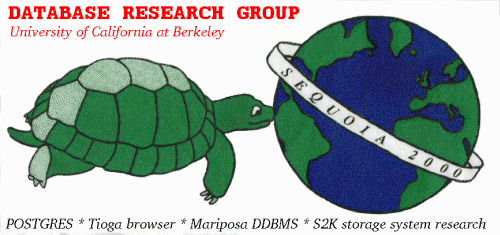The story of the Slonik elephant, the PostgreSQL logo

Hello, Habr!
I always thought that to come up with a logo for a product, if not a couple of trifles, then a matter of a small amount of time. However, the PostgreSQL example shows that this is completely not the case. I bring to your attention a translation of the article by Patricia Dybka, Vertabelo community manager, " History of the Slonik Elephant, PostgreSQL Logo "
Logos are of great importance. What could be better to remind people of a product than an attractive, catchy symbol? With this in mind, today we will answer the question: “Why did PostgreSQL choose an elephant for its logo?”
Each product or company has its own logo - something that identifies and embodies the essence of their brand. Over time, it practically becomes a brand: can you imagine McDonald's without its golden arches? What if the Coca-Cola logo was suddenly painted in purple block print?
Logos evoke emotions that arouse a strong sense of communication and loyalty among consumers. It is remembered by associating an image with a specific product. In this article, we will go back to the nineties and find out how Postgres became associated with the Slonik elephant.
Elephant joins zoo logo
Let's look at a couple of the most popular tech logos. As you can see, the choice of an animal for technology is not something special:
 | Linux has a penguin named Tux. |
 | MySQL has a Sakila dolphin. |
 | PostgreSQL has an elephant known as Slonik. |
Let's look at the reasons Postgres chose the elephant, and how their logo has evolved over the years.
PostgreSQL logo evolution
12/30/1996 Original PostgreSQL logo
The evolutionary process leading to the Postgre elephant has been quite long. One of the earliest Postgres logos was a crumbling wall through which PostgreSQL made its way. The illustration below was taken from the official Postgres website and dates from 1996.

Archive: 12/30/1996 from the earliest available version of postgresql.org , Source
04/03/1997 The emergence of an elephant
By the beginning of 1997, there were big changes in PostgreSQL. January began with a name change: the original name “Postgre95” was replaced by “PostgreSQL”. At this point, official discussions began on the logo; they eventually led to the appearance of an elephant, but other ideas were proposed, as shown in a 1997 post:
Date: 1997-04-03 20:36:33
Some other ideas:
- a sword (derived from the cover of a book with a dragon - Postgres as a tool)
- a bowl of soup with the letters of the alphabet on which POSTGRESQL
is written - revolver / killer (Grosse Pt - Postgres anagram and the abbreviation of the name of the new movie by John Cusack)
but if you want an animal-based logo, what about an elephant? In the end, as the name Agatha Christie says, elephants can remember ...
David Jan
Archive: 04/03/1997 The idea of the Elephant
Source

This may have been the 'Dragon book cover' referred to in the message.
Source: https://en.wikipedia.org/wiki/Compilers:_Principles,_Techniques,_and_Tools
In many cultures, elephants do have excellent memory. (Agatha Christie’s book, Elephants Can Remember, is used as a recurring theme.) The elephant logo can be interpreted in different ways, but the most common is that elephants, as databases, are excellent keepers of information.
This idea gained popularity, but not everyone agreed with it. The following quote, taken from a discussion in the pgsql-hackers postal group in 1997, demonstrates a different understanding of the idea of an elephant:
>> But if you want an animal based logo, what about an elephant?
>> In the end, as the name Agatha Christie says, elephants may remember ...
I am afraid that the elephant will give people a misconception. They think
Postgres is a large, slow, cumbersome database.
Leo
Archive: 04/07/1997
Source
12/12/1997 Cheetah's Logotype?
Despite the fact that the elephant was already chosen for the logo, at the end of 1997 a cheetah was used and the inscription “Empowered PostgreSQL”. The version is shown below. Postgres' brick wall graphics since 1996 have also been used.

Archive: 12/12/1997 Cheetah
Source
1998 - 1999 Elephant breaking through the wall
After the logo with the cheetah, another version was presented: an elephant breaks through a brick wall. Unfortunately, I could not get this drawing, but looked at the following comments:
A bit off topic, I still remember how the logo was an elephant breaking through a brick wall ... And before that it was the word "PostgreSQL" breaking through a brick wall. Unfortunately, in 1998 and 1999 there was a time when we did not archive on WayBack Machine *;* The Wayback Machine - Archive web service. The content of web pages is occasionally recorded using the bot or when the site visitor manually indicates the page address for fixing. Thus, you can see how a particular page looked before, even if it no longer exists.
Lamar Owen
Source
June 1998 Other Postgres Logo Ideas
In June 1998, a further discussion of the pgsql-hackers postal group was full of various logo suggestions, such as:
Lioness or tigress ..
2) Let the lioness rest on top. Its back is on top of the Po. The weight of her forelegs is at “re”, and her forepaws rise at “S”. Her tail wraps around the letter "P", passing under the "Post". He begins to bob down at the end, between "s" and "t". She raised her head and wary, and turned halfway between her gaze forward (on the right) and toward us. The expression on her face is powerful and smug.Alligator...
3) At the top left, that is, above its croup, in smaller letters, there is the text “Powered by”.
4) I think it would be better if the lioness was in motion. This would make it possible to better print the logo on a black and white printer.
If people prefer tigress, you can do the same. But she will not look somehow especially in this position. Keep in mind, I'm not sure how you distinguish a tigress from a tiger.
David Friend, 3.04.1997
Source
Someone came up with an alligator as our totem ... but nobody turned out to be able to come up with a * strong * image to use it :( I kind of like an elephant or a turtle ... they are a little slower, but very reliable ...Cheetah, gazelle, eagle ...
Marc G. Fournier 06/06/1998
A source
Alligators look good, and of course they are very strong. If we have to make an animal, I think that as an original logo it would be right to do something FAST - a cheetah, a gazelle, or a logo with an eagle. He will always be successful in this country :)Dog...
Steve Log June 4, 1998
Source
1) If you really want an animal, why not a DOG? man’s best friend ;-)Or not...
... but I don’t think the animal is a good image for PostgreSQL.Bridge...
Jose Soares da Silva 06/08/1998
Source
I think PostgreSQL is a database system (is a DataBASE system). Therefore, I think the logo should be like some sort of BASE. For example, a bridge is a large and powerful bridge filled with pieces of data. Or trucks filled with data.And, again, the elephant ...
Oleg Breutmann 06/08/1998
Source
> Fri, July 24, 1998, Hermit Hacker writes:
>> We really never were able to come up with a nice image
>> the “talisman” ... the last thing I heard, we looked at the alligator, and some
>> sketches were made, but the final image is not defined ...
quoted1
>> But then, perhaps, the alligator looks too similar to the
> Netscape Mozilla dinosaur (or whatever
> :-), don’t you think?
Hey, I prefer the elephant. Big, strong, reliable and he never forgets anything ...
Dan Delaney 06.23.1998
Source
10/13/1999 Elephant inside a diamond
In October 1999, the cheetah idea on the Postgres logo was completely abandoned. The elephant inside the diamond has become the official logo.

Archive: 02/29/2000 Elephant
Source
02/29/2000 "PostgreSQL Search" with an elephant in a diamond
In February 2000, the elephant and the diamond were combined with the words "Search PostgreSQL."

Archive: 02/29/2000 Elephant
Source
01/28/2003 Current logo
In 2003, a stylized blue elephant was introduced.

Archive: January 28, 2003 Elephant
Source
According to the discussion held in September 2013, the previous logo was considered less than attractive (to say the least!). Shortly after launching PostgreSQL Inc, a blue elephant was developed:
Our first logo was designed by Jan, an elephant in a diamond. Although the idea was good, it didn’t look very good, so when Mark and Greg launched PostgreSQL Inc., they hired a real designer who created the blue elephant we have now. This design was then added to the community.
Josh Berkus, PostgreSQL member, 09/20/2013
Source
08/23/2006 Touch of history
Following the debut of the Blue Elephant logo, relational database history resources started showing PostgreSQL with the new logo along with the date of the original elephant logo.

Archive: 08/23/2006 Elephant
Source
How did the Postgres elephant get its name?

Just by looking at the current logo, any programmer will immediately think “Postgres”. However, not everyone knows that the elephant has a name: Slonik, which comes from the Russian word "elephant". Unfortunately, the date and circumstances of choosing this particular name are unknown. This was probably started by the Postgres Slony-I project. Slony-I is an asynchronous master-slave replication system. Here's what Jan Wieck recalls about this:
By the way, that image on the site had “slonik” as the file name or alternative image text (“alt”), I don’t remember exactly. Then I wondered what that means.Indeed, the name comes from the Russian word “elephants” (slony), which means “elephants”. From this Postgres project, we get the following terminology:
I don’t remember exactly, but isn't that a Russian name for an elephant?
Slon = elephant
Slony = elephants
Slonik = Dumbo
In my replication system, one node is slon (hence the name of the replication engine executable). The group or cluster is called Slony, and the scripting aid used to “query” the various activities is called slonik :)
Jan Wick, July 10, 2004
Source
Slony is a plural word meaning that a cluster consists of several databases.
Slon is a singular word; each replication node is managed by a program called “slon,” which combines into the aforementioned “elephant cluster”.
Slonik is a word meaning “small elephant” and, therefore, the name of the program used to configure the cluster.
Alternative Postgres logo - Turtle
 |  |  |
Source
In some areas, Postgres is presented in a slightly different way. For example, the Japanese PostgreSQL user group (JPUG) - a very active international group - created its own logo instead of the Elephant.
They chose a turtle. Back in the 1970s, the tortoise was used as an INGRES mascot and was left for Postgres. According to the Berkeley Database Group :
The turtle was adopted as a mascot by the INGRES group in the 70s because 'it is slow but always gets where it needs to be.' And it was saved as a mascot of POSTGRES for sentimental reasons.

Source
Why does JPUG use the Postgres tortoise? Some speculate that the blue elephant had inappropriate resemblance to the symbol used by the local terrorist group associated with the 1995 Sarin attack in Tokyo.
As with other products, the Postgres logo has been carefully selected for many years of discussion. And in the end it took its final form: an elephant named Slonik.
Similar stories are quite common. If you know the history of other technical logos, please share them in the comments below.
